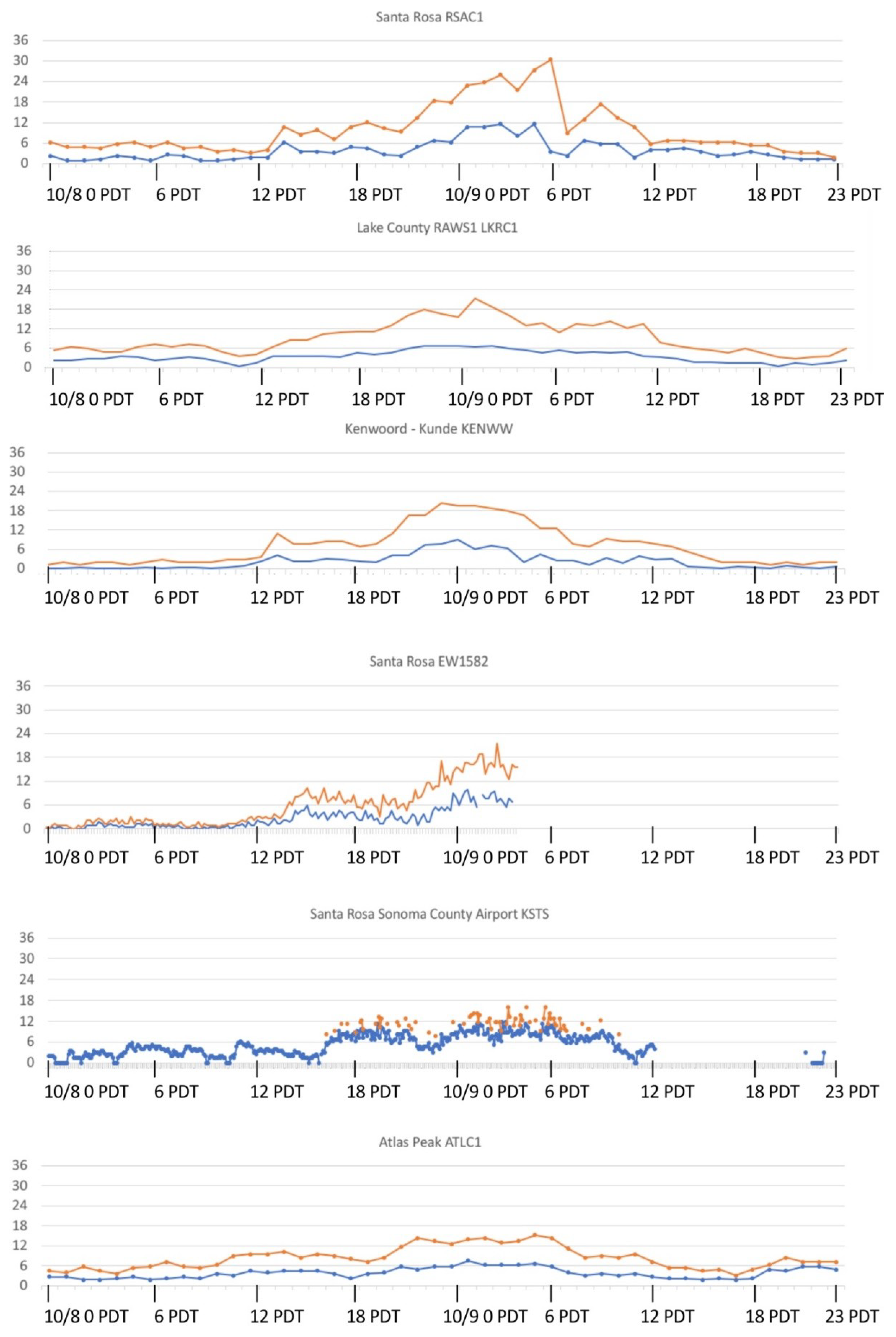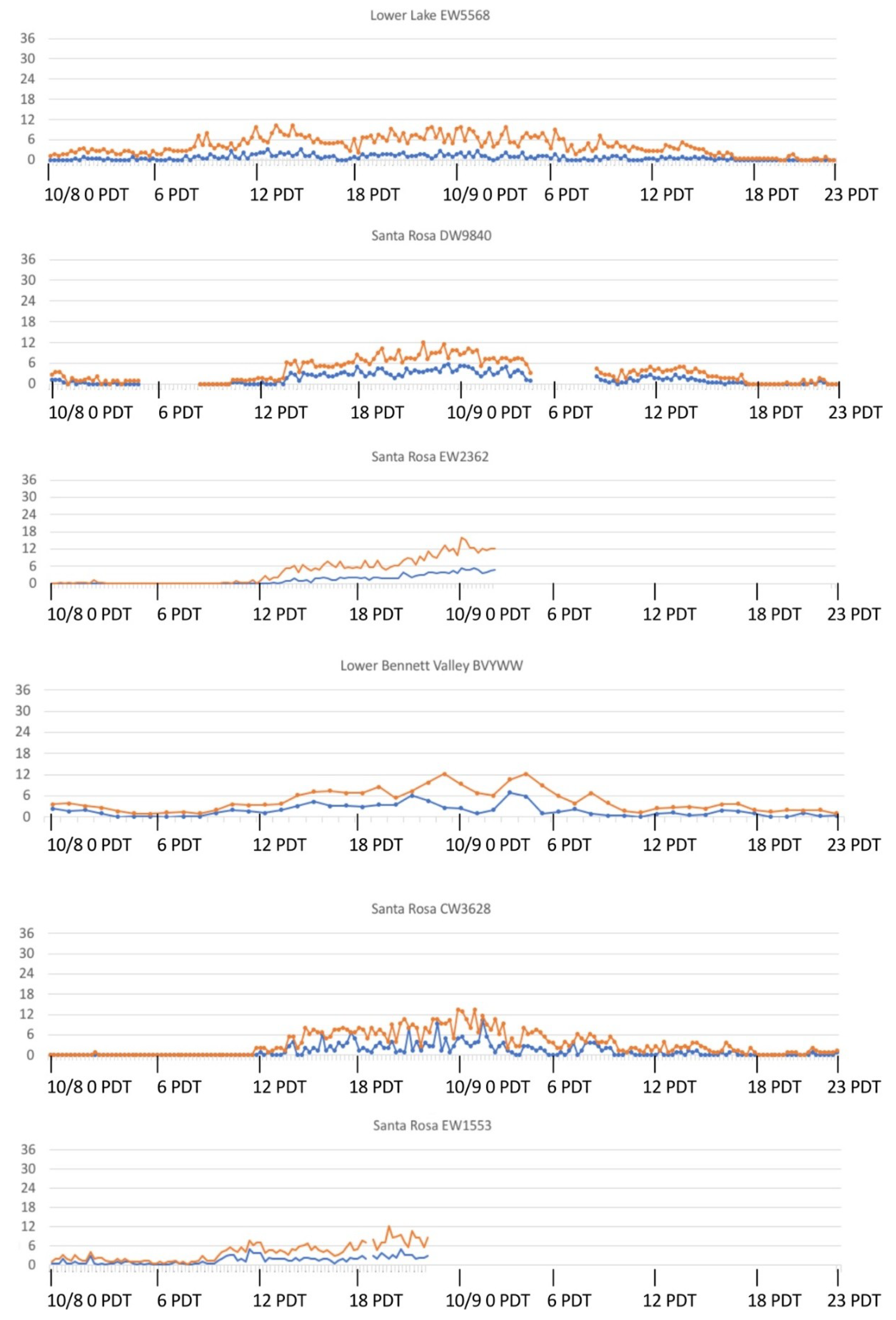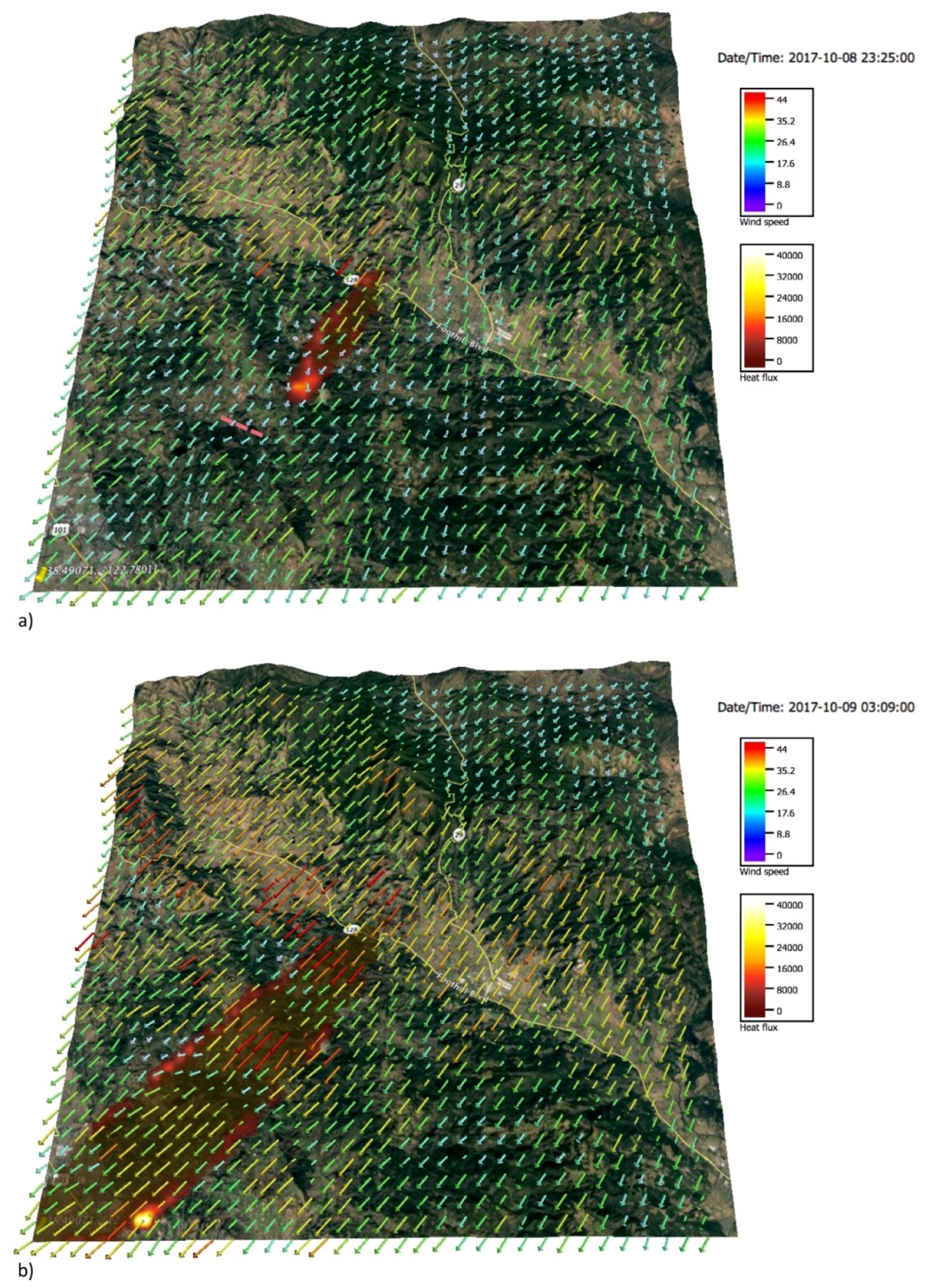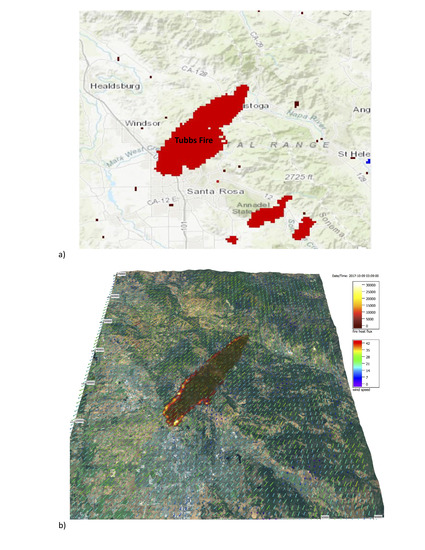The Generation and Forecast of Extreme Winds during the Origin and Progression of the 2017 Tubbs Fire
Abstract
:1. Introduction
2. Overview of Event Environment
3. Materials and Methods
3.1. The CAWFE® Modeling System
3.2. Configuration and Experiments
4. Results
4.1. Regional Winds
4.2. Simulations of Microscale Wind Variability in Time and Space and Resulting Fire Behavior
4.3. Vertical Structure of Wind Speed
4.4. Forecast Configuration
5. Discussion
6. Conclusions
Supplementary Materials
Author Contributions
Funding
Acknowledgments
Conflicts of Interest
References
- CAL FIRE Investigation Report, Case Number 17 CALNU 010049, Case Name Nuns; California Department of Forestry and Fire Protection: Sacramento, CA, USA, 8 October 2017. Available online: http://calfire.ca.gov/fire_protection/downloads/FireReports/Nuns%20LE%2080_Redacted.pdf (accessed on 30 June 2018).
- CAL FIRE Investigation Report, Case Number 17CAMEU012169, Case Name Redwood Incident; California Department of Forestry and Fire Protection: Sacramento, CA, USA, 8 October 2017. Available online: http://calfire.ca.gov/fire_protection/downloads/FireReports/LE-80%20Redwood%20Incident%20Report_Redacted.pdf (accessed on 30 June 2018).
- Monteverdi, J. The Santa Ana weather type and extreme fire hazard in the Oakland-Berkeley Hills. Weatherwise 1973, 26, 118–121. [Google Scholar] [CrossRef]
- Null, J. Weather Corner. San Jose Mercury News, 26 October 1999. [Google Scholar]
- Pagni, P.J. Causes of the 20 October 1991 Oakland Hills conflagration. Fire Saf. J. 1993, 21, 331–339. [Google Scholar] [CrossRef]
- Van Niekerken, B. Wine Country Fire of 1964: Eerie Similarities to this Week’s Tragedy. San Francisco Chronicle. 10 October 2017. Available online: https://www.sfchronicle.com/thetake/article/Wine-Country-fire-of-1964-Eerie-similarities-to-12267643.php (accessed on 31 October 2017).
- Smith, C.; Hatchett, B.; Kaplan, M. Characteristics of Diablo-like Wind conditions in Northern California Based on a Climatology from Surface Observations. Preprints 2018, 1, 25. [Google Scholar] [CrossRef]
- Bowers, C.L.; Clements, C.B. The Diablo Winds of Northern California: Climatology, Severity, and Spatial Characteristics. J. Geophys. Res. Atmos. 2018. submitted. [Google Scholar]
- Nausler, N.J.; Abatzoglou, J.T.; Marsh, P.T. The 2017 North Bay and Southern California Fires: A Case Study. Fire 2018, 1, 18. [Google Scholar] [CrossRef]
- California Public Utilities Commission. PG&E Fire Incident Reports. Available online: http:// http://cpuc.ca.gov/general.aspx?id=6442455196 (accessed on 30 June 2018).
- Coen, J.L.; Riggan, P.J. Simulation and thermal imaging of the 2006 Esperanza wildfire in southern California: Application of a coupled weather-wildland fire model. Int. J. Wildland Fire 2014, 23, 755–770. [Google Scholar] [CrossRef]
- Gohm, A.; Zängl, G.; Mayr, G.J. South Foehn in the Wipp Valley on 24 October 1999 (MAP IOP 10): Verification of high-resolution numerical simulations with observations. Mon. Weather Rev. 2004, 132, 78–102. [Google Scholar] [CrossRef]
- Cao, Y.; Fovell, R.G. Downslope windstorms of San Diego County. Part I: A case study. Mon. Weather Rev. 2016, 144, 529–552. [Google Scholar] [CrossRef]
- Colle, B.A.; Mass, C.A. Windstorms along the Western Side of the Washington Cascade Mountains. Part I: A High-Resolution Observational and Modeling Study of the 12 February 1995 Event. Mon. Weather Rev. 1998, 126, 28–52. [Google Scholar] [CrossRef]
- Colle, B.A.; Mass, C.A. Windstorms along the Western Side of the Washington Cascade Mountains. Part II: Characteristics of Past Events and Three-dimensional Idealized Simulations. Mon. Wea. Rev. 1998, 26, 52–71. [Google Scholar] [CrossRef]
- Clark, T.L.; Peltier, W.R. On the evolution and stability of finite-amplitude mountain waves. J. Atmos. Sci. 1977, 34, 1715–1730. [Google Scholar] [CrossRef]
- Scinocca, J.F.; Peltier, W.R. Pulsating downslope windstorms. Pulsating downslope windstorms. J. Atmos. Sci. 1989, 46, 2885–2914. [Google Scholar] [CrossRef]
- Wilson, J.D. Measured and modelled wind variation over irregularly undulating terrain. Agric. For. Meteorol. 2018, 249, 187–197. [Google Scholar] [CrossRef]
- Hunt, J.C.R.; Richards, K.J. Stratified Airflow over One or Two Hills. In Boundary Layer Structure; Kaplan, H., Dinar, N., Eds.; Springer: Dordrecht, The Netherlands, 1984; ISBN 978-94-009-6516-4. [Google Scholar]
- Finnigan, J.J. Air Flow Over Complex Terrain. In Flow and Transport in the Natural Environment: Advances and Applications; Steffen, W.L., Denmead, O.T., Eds.; Springer: Berlin/Heidelberg, Germany, 1988; ISBN 978-3-642-73847-0. [Google Scholar]
- Miller, C.; Gibbons, M.; Beatty, K.; Boissonnade, A. Topographic speed-up effects and observed roof damage on Bermuda following Hurricane Fabian (2003). Mon. Weather Rev. 2013, 28, 159–174. [Google Scholar] [CrossRef]
- Fernando, H.J.S.; Pardyjak, E.R.; Di Sabatino, S.; Chow, F.K. The MATERHORN: Unraveling the intricacies of mountain weather. Bull. Am. Meteorol. Soc. 2015, 96, 1945–1967. [Google Scholar] [CrossRef]
- Brighton, P.W.M. Strongly stratified flow past three-dimensional obstacles. Quart. J. R. Meteorol. Soc. 1978, 104, 289–307. [Google Scholar] [CrossRef]
- Clark, T.L.; Keller, T.; Coen, J.; Neilley, P.; Hsu, H.; Hall, W.D. Terrain-induced Turbulence over Lantau Island: 7 June 1994 Tropical Storm Russ Case Study. J. Atmos. Sci. 1997, 54, 1795–1814. [Google Scholar] [CrossRef]
- Clark, T.L.; Hall, W.D.; Coen, J.L. Source Code Documentation for the Clark-Hall Cloud- Scale Model Code Version G3CH01; NCAR Technical Note NCAR/TN-426+STR; NCAR: Boulder, CO, USA, 1996. [Google Scholar]
- Coen, J. L. Some requirements for simulating wildland fire behavior using insight from coupled weather-wildland fire models. Fire 2018, 1, 6. [Google Scholar] [CrossRef]
- Coen, J.L. Simulation of the Big Elk Fire using coupled atmosphere—Fire modeling. Int. J. Wildland Fire 2005, 14, 49–59. [Google Scholar] [CrossRef]
- Coen, J.L. Modeling Wildland Fires: A Description of the Coupled Atmosphere-Wildland Fire Environment Model (CAWFE); NCAR Technical Note NCAR/TN-500+STR; NCAR: Boulder, CO, USA, 2013. [Google Scholar]
- Rothermel, R.C. A Mathematical Model for Predicting Fire Spread in Wildland Fuels; Research Paper INT-115; USDA Forest Service, Intermountain Forest and Range Experiment Station: Ogden, UT, USA, 1972.
- Van Wagner, C.E. Conditions for the start and spread of crown fire. Can. J. For. Res. 1977, 7, 23–34. [Google Scholar] [CrossRef]
- Rothermel, R.C. Predicting Behavior and Size of Crown Fires in the Northern Rocky Mountains; Research Paper INT-438; USDA Forest Service: Ogden, UT, USA, 1991.
- Koo, E.; Linn, R.R.; Pagni, P.; Edminster, C. Modeling firebrand transport in wildfires using HIGRAD/FIRETEC. Int. J. Wildland Fire 2012, 21, 396–417. [Google Scholar] [CrossRef]
- Anderson, H.E. Aids to Determining Fuel Models for Estimating Fire Behavior; USDA Forest Service, Intermountain Forest and Range Experiment Station, General Technical Report INT-122; USDA: Ogden, UT, USA, 1982.
- Scott, J.H.; Burgan, R.E. Standard Fire Behavior Fuel Models: A Comprehensive Set for Use with Rothermel’s Surface Fire Spread Model; USDA For. Serv. Gen. Tech. Rep. RMRS-GTR-153; USDA: Ogden, UT, USA, 2005.
- Ottmar, R.D.; Sandberg, D.V.; Riccardi, C.L.; Prichard, S.J. An overview of the Fuel Characteristic Classification System—Quantifying, classifying, and creating fuelbeds for resource planning. Can. J. For. Res. 2007, 37, 2383–2393. [Google Scholar] [CrossRef]
- Coen, J.L.; Stavros, E.N.; Fites-Kaufman, J.-A. Deconstructing the King megafire. Ecol. Appl. 2018. [Google Scholar] [CrossRef] [PubMed]
- LANDFIRE. Existing Vegetation Type Layer, LANDFIRE 1.1.0, U.S. Department of the Interior, Geological Survey. 2008. Available online: http://landfire.cr.usgs.gov/viewer/ (accessed on 28 October 2010).
- Albini, F.A. Estimating Wildfire Behavior and Effects; USDA Forest Service Intermountain Forest and Range Experiment Station, General Technical Report INT-30; USDA: Ogden, UT, USA, 1976.
- Coen, J.L.; Schroeder, W. Use of spatially refined remote sensing fire detection data to initialize and evaluate coupled weather-wildfire growth model simulations. Geophys. Res. Lett. 2013, 40, 5536–5541. [Google Scholar] [CrossRef]
- Forthofer, J.M.; Butler, B.W.; Wagenbrenner, N.S. A comparison of three approaches for simulating fine-scale surface winds in support of wildland fire management. Part I. Model formulation and comparison against measurements. Int. J. Wildland Fire 2014, 23, 969–981. [Google Scholar] [CrossRef]
- Kochanski, A.K.; Jenkins, M.A.; Mandel, J.; Beezley, J.D.; Krueger, S.K. Real time simulation of 2007 Santa Ana fires. For. Ecol. Manag. 2013, 294, 136–149. [Google Scholar] [CrossRef]
- Kosovic, B.; Mahoney, W.P.; Brown, B.G.; Cowie, J.R.; Anderson, A.; Boehnert, J.; Bresch, J.; Jimenez, P.A.; Munoz-Esparza, D.; Petzke, W.; et al. Advancements in Operational Wildland Fire Prediction; NCAR Day of Networking and Discovery 2017; National Center for Atmospheric Research (NCAR): Boulder, CO, USA, 2017. [Google Scholar]
- Mukherjee, S.; Schalkwijk, J.; Jonker, H.J.J. Predictability of dry convective boundary layers: An LES study. J. Atmos. Sci. 2016, 73, 2715–2727. [Google Scholar] [CrossRef]
- Coen, J.L.; Schroeder, W. The High Park Fire: Coupled weather-wildland fire model simulation of a windstorm-driven wildfire in Colorado’s Front Range. J. Geophys. Res. Atmos. 2015, 120, 131–146. [Google Scholar] [CrossRef]












© 2018 by the authors. Licensee MDPI, Basel, Switzerland. This article is an open access article distributed under the terms and conditions of the Creative Commons Attribution (CC BY) license (http://creativecommons.org/licenses/by/4.0/).
Share and Cite
Coen, J.L.; Schroeder, W.; Quayle, B. The Generation and Forecast of Extreme Winds during the Origin and Progression of the 2017 Tubbs Fire. Atmosphere 2018, 9, 462. https://doi.org/10.3390/atmos9120462
Coen JL, Schroeder W, Quayle B. The Generation and Forecast of Extreme Winds during the Origin and Progression of the 2017 Tubbs Fire. Atmosphere. 2018; 9(12):462. https://doi.org/10.3390/atmos9120462
Chicago/Turabian StyleCoen, Janice L., Wilfrid Schroeder, and Brad Quayle. 2018. "The Generation and Forecast of Extreme Winds during the Origin and Progression of the 2017 Tubbs Fire" Atmosphere 9, no. 12: 462. https://doi.org/10.3390/atmos9120462





